Recent News
- Navigating the Future: Advancements in NLP for Enhanced Healthcare June 19, 2024
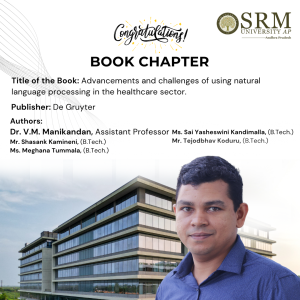 In a significant contribution to the intersection of technology and healthcare, Dr V M Manikandan, Assistant Professor in the Department of Computer Science and Engineering along with a team of dedicated undergraduate students, has co-authored a pivotal book chapter. The chapter, titled “Advancements and Challenges of Using Natural Language Processing in the Healthcare Sector,” has been published in the insightful book “Digital Transformation in Healthcare 5.0.”
In a significant contribution to the intersection of technology and healthcare, Dr V M Manikandan, Assistant Professor in the Department of Computer Science and Engineering along with a team of dedicated undergraduate students, has co-authored a pivotal book chapter. The chapter, titled “Advancements and Challenges of Using Natural Language Processing in the Healthcare Sector,” has been published in the insightful book “Digital Transformation in Healthcare 5.0.”The collaborative effort by Dr Manikandan, Mr Shasank Kamineni, Ms Meghana Tummala, Ms Sai Yasheswini Kandimalla, and Mr Tejodbhav Koduru delves into the innovative applications and potential hurdles of implementing natural language processing (NLP) technologies in healthcare. Their work highlights the transformative power of NLP in analysing vast amounts of unstructured clinical data, thereby enhancing patient care and medical research.
This academic achievement showcases the expertise and commitment of the faculty and students and underscores the institution’s role in driving forward the digital revolution in healthcare. The chapter is expected to serve as a valuable resource for researchers, practitioners, and policymakers interested in developing smarter, more efficient healthcare systems.Introduction of the Book Chapter
“Digital Transformation in Healthcare 5.0: IoT, AI, and Digital Twin” delves into how advanced technologies like IoT, AI, and digital twins are reshaping healthcare. It provides a comprehensive look at the integration challenges and technological advancements aiming to modernise medical practices. The chapter “Advancements and Challenges of Using Natural Language Processing in the Healthcare Sector” specifically explores how NLP processes vast data in healthcare to transform it into actionable insights, enhancing efficiency and patient care while highlighting the implementation challenges of these technologies. This book is crucial for healthcare and technology professionals interested in the future of digitally enhanced healthcare.
Significance of the Book Chapter
The chapter “Advancements and Challenges of Using Natural Language Processing in the Healthcare Sector” is significant because it encapsulates my interest and expertise in harnessing NLP to enhance healthcare operations. It showcases the potential of technology in transforming healthcare data into valuable, actionable insights, directly aligning with my focus on improving patient outcomes through technological innovation.
Continue reading → - Dr Manjula R and Students Publish Book Chapter on Machine Learning in 6G Networks May 7, 2024
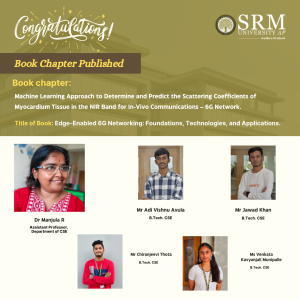 In an exciting development, Dr Manjula R, Assistant Professor in the Department of Computer Science and Engineering, along with B.Tech. students Mr Adi Vishnu Avula, Mr Jawad Khan, Mr Chiranjeevi Thota, and Ms Venkata Kavyanjali Munipalle, have authored a book chapter titled “Machine Learning Approach to Determine and Predict the Scattering Coefficients of Myocardium Tissue in the NIR Band for In-Vivo Communications – 6G Network in book name “Edge-Enabled 6G Networking: Foundations, Technologies, and Applications”.
In an exciting development, Dr Manjula R, Assistant Professor in the Department of Computer Science and Engineering, along with B.Tech. students Mr Adi Vishnu Avula, Mr Jawad Khan, Mr Chiranjeevi Thota, and Ms Venkata Kavyanjali Munipalle, have authored a book chapter titled “Machine Learning Approach to Determine and Predict the Scattering Coefficients of Myocardium Tissue in the NIR Band for In-Vivo Communications – 6G Network in book name “Edge-Enabled 6G Networking: Foundations, Technologies, and Applications”.This achievement highlights the innovative research and collaboration showcase the dedication and expertise of both faculty and students in the field of computer science and engineering. The book chapter explores the cutting-edge advancements in 6G networking and its potential applications, shedding light on the future of communication technologies.
We congratulate Dr Manjula R and the team of talented students on this significant accomplishment and look forward to seeing more groundbreaking research from them in the future. Stay tuned for more updates on their work and achievements.
Abstract
The accurate calculation of the scattering coefficient of biological tissues (myocardium) is critical for estimating the path losses in prospective 6-G in-vivo Wireless Nano sensor networks (i-WNSN). This research explores machine learning’s potential to promote non-invasive procedures and improve in-vivo diagnostic system’s accuracy while determining myocardium’s scattering properties in the Near Infrared (NIR) frequency. We begin by presenting the theoretical model used to estimate and calculate scattering coefficients in the NIR region of the EM spectrum. We then provide numerical simulation results using the scattering coefficient model, followed by machine learning models such as Linear Regression, Polynomial Regression, Gradient Boost and ANN (Artificial Neural Network) to estimate the scattering coefficients in the wavelength range 600-900 nm.
We next contrast the values provided by the analytical model with those predicted via machine learning models. In addition, we also investigate the potential of machine learning models in producing new data sets using data expansion techniques to forecast the scattering coefficient values of the unavailable data sets. Our inference is that machine learning models are able to estimate the scattering coefficients with very high accuracy with gradient boosting performing better than other three models. However, when it comes to the prediction of the extrapolated data, ANN is performing better than other three models.
Keywords: 6G, In-vivo, Dielectric Constant, Nano Networks, Scattering Coefficient, Machine Learning.
Significance of Book Chapter
The human heart is a vital organ of the cardiovascular system and is very crucial for any living being. However, this organ is prone to several diseases—Cardiovascular Disease (CVD)—an umbrella term. CVDs are the set of the heart diseases that comprises heart attack, cardiac arrest, arrhythmias, cardiomyopathy, atherosclerosis to name a few. CVD alone account for most of the deaths across the globe and is estimated reach 23.3 million deaths due to CVD by 2030. Early detection and diagnosis of CVD is the ultimate solution to mitigate these death rates. Current diagnostic tests include, however not the exhaustive list, ECG, blood test, cardiac x-ray, angiogram.
The limitations of these techniques include bulkiness of the equipment, cost, tests are suggested only when things are in critical stage. To alleviate these issues, we are now blessed with on-body or wearable devices such as smart watches that collect timely information about the cardiac health parameters and notify the user in a real-time. However, these smart watches do not have the capability to directly detect the presence of plaque in the arteries that leads to atherosclerosis. These devices have the capability to track certain health parameters such as heart rate, blood pressure, other activity levels, any deviation in the measured values of these parameters from the normal values might give an indication of cardiac health issues. This requires a formal diagnostics test such as cardiac catheterization or cardiac x-ray leading to the original problem.
Therefore, in this work we aim to mitigate these issues by proposing the usage of prospective medical grade nanorobots—called nanosurgeons, that can provide real-time live information on the health condition of the internal body. Particularly, our work assumes that these tiny nanobots are injected into the cardiovascular system that keep circulating along with the blood to gather health information. Such nanosized robots are typically expected to work in the terahertz band owing to their size. At such high frequency, the terahertz signals are prone to high path losses due to spreading, absorption and scattering of the signal during propagation. Our work aims at understanding these losses, especially the scattering losses, of the terahertz signal in the NIR band (600-900 nm) using the existing models, analytically. Further, to understand the strength of machine learning in predicting these scattering losses, we also carryout simulation work to estimate and predict the scattering losses using Linear Regression, Polynomial Regression, Gradient Boost and Artificial Neural Network (ANN) models.
Our preliminary investigation suggests scattering losses are minimal in NIR band and machine learning can be seen as a potential candidate for perdiction of scattering losses using the available experimental data as well as using data augmentation techniques to predict the scattering losses at those frequencies for which either experimental data is not available or can prevent the use of costly equipment to determine these parameters.
Continue reading → - GPEMC Sanctions Consultancy Project Worth 48.9 Lakhs April 30, 2024
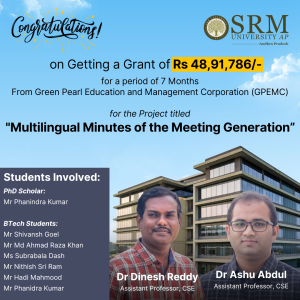 Green Pearl Education and Management Corporation (GPEMC) has recently sanctioned a significant consultancy project to SRM University-AP, titled “Multilingual Minutes of the Meeting Generation.” This project aims to develop innovative solutions for generating multilingual minutes of meetings, ensuring effective communication, and understanding across language barriers.
Green Pearl Education and Management Corporation (GPEMC) has recently sanctioned a significant consultancy project to SRM University-AP, titled “Multilingual Minutes of the Meeting Generation.” This project aims to develop innovative solutions for generating multilingual minutes of meetings, ensuring effective communication, and understanding across language barriers.The Consultancy Project has been assigned to Dr. Ashu Abdul and Dr. Dinesh Reddy Vemula, Assistant Professors for a period of 7 months from the Department of Computer Science and Engineering (CSE). Their expertise in language processing and computational linguistics will play a crucial role in the successful execution of this project.
Joining them in this endeavour is Mr Phanindra Kumar, a dedicated PhD scholar, and a team of talented B.Tech. students, including Mr Shivansh Goel, Mr Md Ahmad Raza Khan, Ms Subrabala Dash, Mr Nithish Sri Ram, Mr Hadi Mahmood, and Mr Phanidra Kumar. Their combined skills and enthusiasm will contribute to the development of innovative solutions for multilingual meeting documentation.
The Consultancy Project has been sanctioned with an outlay of Rs 48,91,786/- as consultancy charges for a period of 7 months. This funding will support the research and development efforts required to deliver efficient and accurate multilingual minutes of meetings.
The objective of this project is to create an automated system that can generate minutes of meetings in multiple languages, ensuring accurate and comprehensive documentation. By overcoming language barriers, this project aims to facilitate effective communication and collaboration in diverse organizational settings.
The collaboration between SRM University-AP and GPEMC highlights the commitment of both institutions to research and innovation. This consultancy project presents an exciting opportunity for the faculty members and students to contribute to real-world problem-solving and make a substantial impact in the field of language processing.
Abstract
The project ‘Multilingual Minutes of the Meeting Generation’ aims to develop an innovative application that automates the creation of meeting minutes, action plans, and summaries in multiple languages. Leveraging advanced research in natural language processing and speech recognition technologies, our application seeks to streamline the tedious and time-consuming task of minute-taking. It will do so by accurately identifying, associating, and documenting statements with their respective speakers during meetings using speech diarization techniques.
The primary objective is to enhance the efficiency and accuracy of meeting minutes while supporting diverse linguistic needs and eliminating human error, thereby catering to global business environments. The system will improve the meeting outcomes for all participants by identifying the action items from the meeting. This project intends to deliver an effective solution for enterprises by combining the latest technological advances with a user-centric design.
Explanation of the Research in Layperson’s Terms
The project called “Multilingual Minutes of the Meeting Generation” is about creating a new tool that automatically writes down what happens in meetings—like the minutes, action items, and summaries—and can do this in several languages. This tool uses the latest technology in understanding and processing human speech, which helps make the task of recording meeting details much faster and easier.
The special feature of this tool is its ability to figure out who is speaking and accurately attach their words to them in the meeting notes. This makes sure the meeting records are both correct and detailed. The main goal here is to make creating and keeping track of meeting records more efficient and accurate, help people who speak different languages, and reduce mistakes that can happen when humans take down notes.
This system is especially useful in today’s global business setting, where people from different parts of the world need to work together smoothly. It aims to lessen the work involved in manually writing meeting notes and make the results easier for everyone to use and understand. Overall, the project promises to blend cutting-edge technology with designs that focus on the needs of the users to provide a practical tool for businesses.
Practical Implementation or the Social Implications Associated with the Research
The practical implementation of this project is particularly beneficial for enterprises, institutions, and professional settings where meetings are frequent. By automating minute-taking, it allows participants to focus more on discussion and decision-making, rather than note-taking. This leads to more productive meetings and ensures that important details are not lost or misinterpreted. Ultimately, this technology enhances communication and documentation accuracy across diverse linguistic and cultural landscapes in business and professional environments.
Collaborations
This project is being developed in collaboration with the members of the Next Tech Lab AP at SRM University-AP
Future Research Plans
The future plans for this project involve integrating the application with widely used platforms such as Zoom, Google Meet, and others that support video/audio conferencing. This integration aims to seamlessly incorporate the automated minute-taking functionality into these platforms, enhancing accessibility and usability for users across various companies and institutions. By expanding compatibility with popular conferencing tools, the project seeks to further streamline meeting documentation processes and cater to a broader user base in diverse professional settings.
Continue reading → - Revolutionising Energy Harvesting: Dr Banee Banadana Receives Patent for Innovative System April 15, 2024
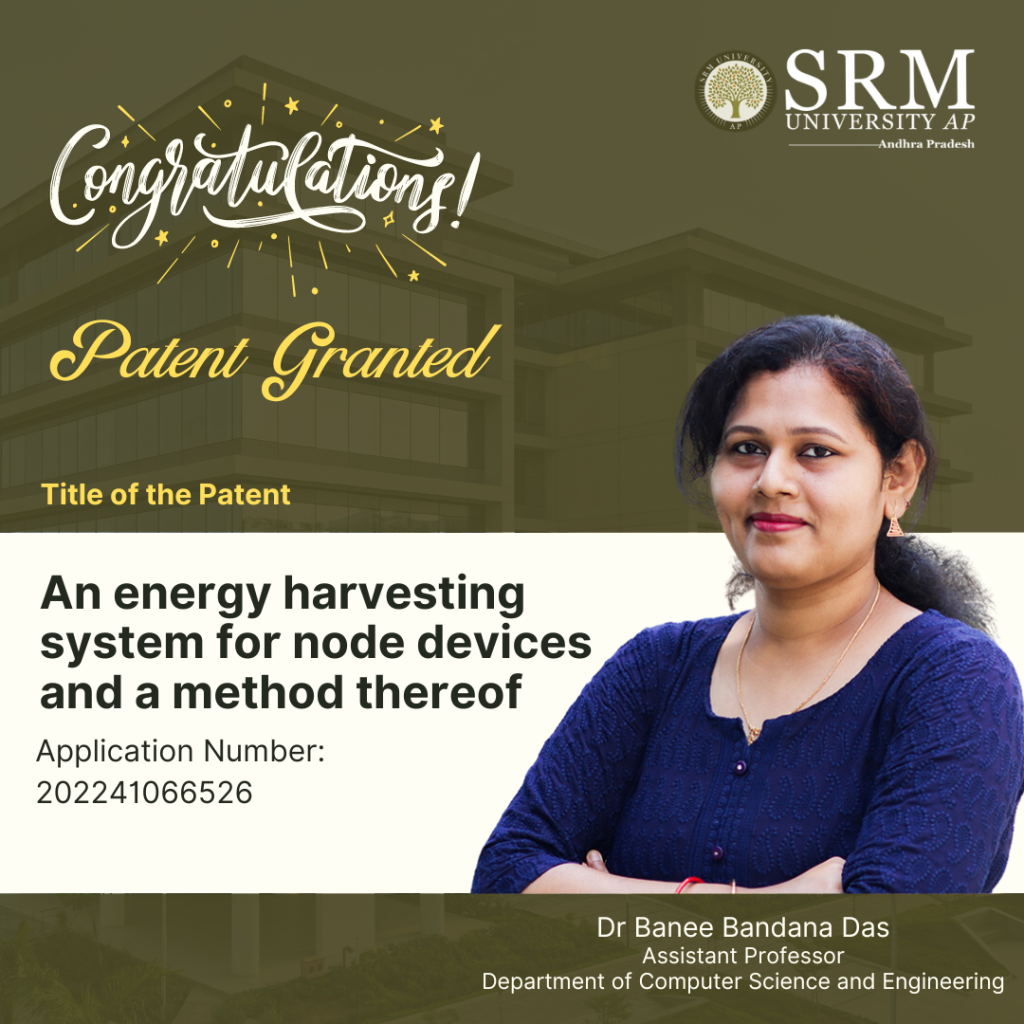
Dr Banee Bandana Das, Assistant Professor in the Department of Computer Science and Engineering, has achieved a remarkable milestone. The invention titled “An Energy Harvesting System for Node Devices and a Method Thereof” has been granted a patent by the Patent Office Journal, under Application Number: 202241066526. This achievement marks a significant leap forward in the realm of energy harvesting systems, promising a brighter and more secure future for IoT applications.
Abstract
The present invention is broadly related to design of secure and Trojan Resilient energy harvesting system (EHS) for IoT end node devices. The objective is to develop a state-of-the-art energy harvesting system which can supply uninterrupted power to the sensors used in IoT. The EHS is self-sustainable. The higher bias voltages are generated on chip. The system is mainly consisting of security module, power conditioning module, Trojan Resilient module, and load controller module. The power failure of the sensors used in IoT may leads to information loss thereby causing catastrophic situations. An uninterrupted power supply is a must for smooth functioning of the devices in IoT. This invention caters secure power requirements with security issues of IoT end node devices.
Practical Implementation:
The IoT end node devices needs 24*7 power supply and are very sensitive to attacks made by adversaries before and after fabrication. This invention takes care of the power requirement of end node devices with green energy and secure the EHS-IC from adversaries and attacks and therefore can be used by individuals, as powering sensors at remote locations and as part of smart agriculture.
Future research plans:
Design more secure and reliable design for making a IoT smart node smarter and self-Sustainable. Exploring more circuit level techniques and find new way to design more power efficient designs.
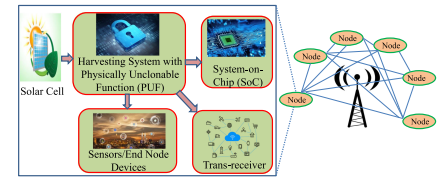
Continue reading → - April 15, 2024
Dr Banee Bandana Das, Assistant Professor in the Department of Computer Science and Engineering, has achieved a remarkable milestone. The invention titled “An Energy Harvesting System for Node Devices and a Method Thereof” has been granted a patent by the Patent Office Journal, under Application Number: 202241066526. This achievement marks a significant leap forward in the realm of energy harvesting systems, promising a brighter and more secure future for IoT applications.
Abstract
The present invention is broadly related to design of secure and Trojan Resilient energy harvesting system (EHS) for IoT end node devices. The objective is to develop a state-of-the-art energy harvesting system which can supply uninterrupted power to the sensors used in IoT. The EHS is self-sustainable. The higher bias voltages are generated on chip. The system is mainly consisting of security module, power conditioning module, Trojan Resilient module, and load controller module. The power failure of the sensors used in IoT may leads to information loss thereby causing catastrophic situations. An uninterrupted power supply is a must for smooth functioning of the devices in IoT. This invention caters secure power requirements with security issues of IoT end node devices.
Practical Implementation:
The IoT end node devices needs 24*7 power supply and are very sensitive to attacks made by adversaries before and after fabrication. This invention takes care of the power requirement of end node devices with green energy and secure the EHS-IC from adversaries and attacks and therefore can be used by individuals, as powering sensors at remote locations and as part of smart agriculture.
Future research plans:
Design more secure and reliable design for making an IoT smart node smarter and self-Sustainable. Exploring more circuit level techniques and find new way to design more power efficient designs.
Continue reading →

